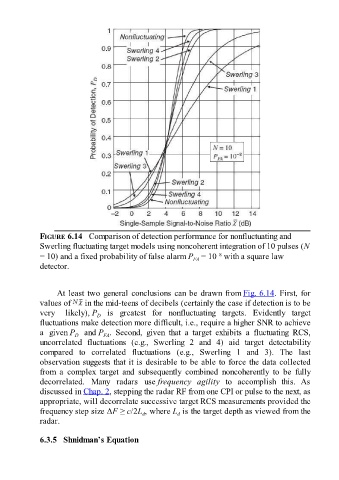Page 489 - Fundamentals of Radar Signal Processing
P. 489
FIGURE 6.14 Comparison of detection performance for nonfluctuating and
Swerling fluctuating target models using noncoherent integration of 10 pulses (N
–8
= 10) and a fixed probability of false alarm P = 10 with a square law
FA
detector.
At least two general conclusions can be drawn from Fig. 6.14. First, for
values of in the mid-teens of decibels (certainly the case if detection is to be
very likely), P is greatest for nonfluctuating targets. Evidently target
D
fluctuations make detection more difficult, i.e., require a higher SNR to achieve
a given P and P . Second, given that a target exhibits a fluctuating RCS,
D
FA
uncorrelated fluctuations (e.g., Swerling 2 and 4) aid target detectability
compared to correlated fluctuations (e.g., Swerling 1 and 3). The last
observation suggests that it is desirable to be able to force the data collected
from a complex target and subsequently combined noncoherently to be fully
decorrelated. Many radars use frequency agility to accomplish this. As
discussed in Chap. 2, stepping the radar RF from one CPI or pulse to the next, as
appropriate, will decorrelate successive target RCS measurements provided the
frequency step size ΔF ≥ c/2L , where L is the target depth as viewed from the
d
d
radar.
6.3.5 Shnidman’s Equation

